Critical requirement of SOS1 for tumor development and microenvironment modulation in KRASG12D-driven lung adenocarcinoma
- PMID: 37730692
- PMCID: PMC10511506
- DOI: 10.1038/s41467-023-41583-1
Critical requirement of SOS1 for tumor development and microenvironment modulation in KRASG12D-driven lung adenocarcinoma
Abstract
The impact of genetic ablation of SOS1 or SOS2 is evaluated in a murine model of KRASG12D-driven lung adenocarcinoma (LUAD). SOS2 ablation shows some protection during early stages but only SOS1 ablation causes significant, specific long term increase of survival/lifespan of the KRASG12D mice associated to markedly reduced tumor burden and reduced populations of cancer-associated fibroblasts, macrophages and T-lymphocytes in the lung tumor microenvironment (TME). SOS1 ablation also causes specific shrinkage and regression of LUAD tumoral masses and components of the TME in pre-established KRASG12D LUAD tumors. The critical requirement of SOS1 for KRASG12D-driven LUAD is further confirmed by means of intravenous tail injection of KRASG12D tumor cells into SOS1KO/KRASWT mice, or of SOS1-less, KRASG12D tumor cells into wildtype mice. In silico analyses of human lung cancer databases support also the dominant role of SOS1 regarding tumor development and survival in LUAD patients. Our data indicate that SOS1 is critically required for development of KRASG12D-driven LUAD and confirm the validity of this RAS-GEF activator as an actionable therapeutic target in KRAS mutant LUAD.
© 2023. Springer Nature Limited.
Conflict of interest statement
The authors declare no competing interests.
Figures
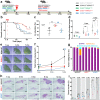


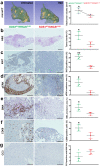
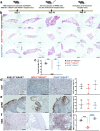
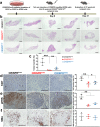
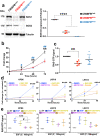

Similar articles
-
SOS1 inhibitor BI-3406 shows in vivo antitumor activity akin to genetic ablation and synergizes with a KRASG12D inhibitor in KRAS LUAD.Proc Natl Acad Sci U S A. 2025 Mar 18;122(11):e2422943122. doi: 10.1073/pnas.2422943122. Epub 2025 Mar 12. Proc Natl Acad Sci U S A. 2025. PMID: 40073053
-
Trametinib sensitizes KRAS-mutant lung adenocarcinoma tumors to PD-1/PD-L1 axis blockade via Id1 downregulation.Mol Cancer. 2024 Apr 20;23(1):78. doi: 10.1186/s12943-024-01991-3. Mol Cancer. 2024. PMID: 38643157 Free PMC article.
-
TRIM58 is a prognostic biomarker remodeling the tumor microenvironment in KRAS-driven lung adenocarcinoma.Future Oncol. 2021 Feb;17(5):565-579. doi: 10.2217/fon-2020-0645. Epub 2021 Jan 7. Future Oncol. 2021. PMID: 33406903
-
Next batter up! Targeting cancers with KRAS-G12D mutations.Trends Cancer. 2023 Nov;9(11):955-967. doi: 10.1016/j.trecan.2023.07.010. Epub 2023 Aug 15. Trends Cancer. 2023. PMID: 37591766 Review.
-
SOS2 Comes to the Fore: Differential Functionalities in Physiology and Pathology.Int J Mol Sci. 2021 Jun 21;22(12):6613. doi: 10.3390/ijms22126613. Int J Mol Sci. 2021. PMID: 34205562 Free PMC article. Review.
Cited by
-
Clinical Advances and Challenges in Targeting KRAS Mutations in Non-Small Cell Lung Cancer.Cancers (Basel). 2024 Nov 20;16(22):3885. doi: 10.3390/cancers16223885. Cancers (Basel). 2024. PMID: 39594840 Free PMC article. Review.
-
SOS1 Inhibition Enhances the Efficacy of KRASG12C Inhibitors and Delays Resistance in Lung Adenocarcinoma.Cancer Res. 2025 Jan 2;85(1):118-133. doi: 10.1158/0008-5472.CAN-23-3256. Cancer Res. 2025. PMID: 39437166 Free PMC article.
-
Screening Enamine Fragments Library in the Quest for Novel SOS2 Inhibitors: Pharmacophore Modelling, Molecular Docking, MMGBSA Calculations, and MD Simulation.J Pharm Bioallied Sci. 2025 Jun;17(Suppl 2):S1894-S1899. doi: 10.4103/jpbs.jpbs_534_25. Epub 2025 Jun 18. J Pharm Bioallied Sci. 2025. PMID: 40655702 Free PMC article.
-
Genetics and biology of pancreatic ductal adenocarcinoma.Genes Dev. 2025 Jan 7;39(1-2):36-63. doi: 10.1101/gad.351863.124. Genes Dev. 2025. PMID: 39510840 Free PMC article. Review.
-
Precision immune regulation in KRAS-mutated cancers: the final piece of the puzzle?J Exp Clin Cancer Res. 2025 Jul 3;44(1):189. doi: 10.1186/s13046-025-03444-1. J Exp Clin Cancer Res. 2025. PMID: 40611261 Free PMC article. Review.
References
Publication types
MeSH terms
Substances
LinkOut - more resources
Full Text Sources
Medical
Molecular Biology Databases
Research Materials
Miscellaneous

